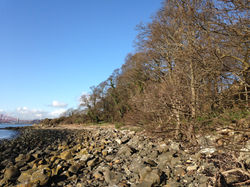Drought and Biodiversity: Why we need our wild spaces.
It tends to be taken for granted that having some wild areas of grass, flowers, and trees is a good thing, but the recent long spell of dry weather helps to highlight why this is so, and why we must do all we can to protect the wild places we have, no matter how small.
The recent spell of no rain and a lot of sunshine turned lawns brown. But while we could turn on the hosepipe and provide some relief from the drought in our gardens, the wild spaces around us had to cope with what the weather brought. Last year saw a long spell with almost no rain from mid-March to mid-May. This year’s exceptional dry weather began in early April and continued to mid-July. Fortunately the last few days have bought some welcome rain so at least the surface layers of soil have moisture again.
These climate extremes are not uncommon, though they are becoming more frequent, and their effect is to place severe stresses on the natural ecology around us, and that starts with the plants. They are the basis of all the food chains that lead to butterflies and moths, bumblebees and other insects, and ultimately to birds and mammals. As always, there are some winners as well as many losers.
The effect is at its harshest where soils are thin. These are already colonised by plants that can stand periods of little rain, but this year has been extreme. The west facing slope up to the gun emplacements shows this very well. Wild Thyme already grows there and had been expanding following last year’s drought. It’s tough green leaves and purple flowers in July this year show how well adapted it is to dry conditions as it sits among the shrivelled leaves of normally tough grasses and other plants. So in these conditions it is able to survive when other plants fail.

A look at our wildflower area also showed that many of the native wildflowers there were suffering too. Many have had a premature end to flowering, and the grasses that cover the bank, and provide food for many butterfly and moth caterpillars, are not producing the soft new growth that they need to feed on.

At this time of year our wildflower bank should have some areas covered in the rich purple blooms of Tufted Vetch, a valuable source of nectar for several bumblebee species. These photos from late July 2016 show what should have been seen.


But this year it was hard to find any in flower, and of those that were, some blooms were withering before they even opened.

Fortunately some of the plants that are adapted to drier conditions were continuing to flower, so we had both Common and Greater Knapweed, Field Scabious, Ragwort and Lady’s Bedstraw all in flower and they stood out against the dryness around them giving a little colour for us to enjoy, and providing nectar and pollen sources for at least some of the pollinating insects.





Despite these bright spots, the effect of the drought is that the numbers and diversity of insects will have suffered a reduction this summer, and this is bound to affect the food supply of all the other creatures that feed in our area, including the birds and bats. If they cannot fatten up on insects before the winter arrives, some may not survive it. After all, not all birds come to garden bird feeders.
There is a longer term effect as well. When plant and insect numbers become too small, severe conditions like those we have experienced can lead to local extinctions. This is a normal state of affairs in a variable climate, and when there are plenty of similar habitats reasonably close there will be survivors in some of them that can recolonise. But our wild spaces are becoming increasingly reduced in size and separated from each other, making this recolonisation more difficult and uncertain. This is why we need to make sure that those wild spaces that we have are protected and looked after so that they can continue to contain as wide a diversity of wild plants as possible which can then support the multitude of other species that depend on them.







































